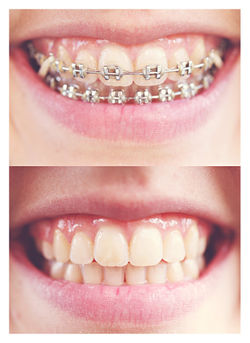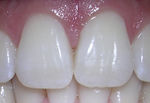Dental braces
Dental braces are devices used in orthodontics that align and straighten teeth. Modern day braces were derived from ancient techniques used by the Egyptians and Romans. As the search for better ways to straighten misaligned teeth continued numerous Orthodontists or Doctors looked for better answers to change their standard. Proper care for the patient has changed quite a bit and there are newer methods Dentists use to ensure the safety of the patient as well as straighten the teeth.
History
The desire for straight teeth dates as far back to ancient times when the ancient Egyptians tried to use crude metal bands in an effort to re-align the teeth as well as also used catgut, string made of intestines from sheep and horses, to close gaps, attaching to the metal bands and provided pressure allowing the teeth to move fluidly.The ancient Egyptians were not the only ones who tried to re-align crooked teeth, 400-500 BC, Hippocrates and Aristotle both tried to come up with a better way to straighten teeth as well as change the dental conditions of their time. A archaeologist discovered the use of gold wire in a roman tomb used to bind the teeth in attempt to re-align them.This was the first known use of ligature wire. During Medieval times, 'specialized barbers' a.k.a the teeth cutters, performed extractions in order to take out decaying teeth, as well as extracted blood for therapeutic purposes. Aurelius Cornelius Celsus, alive during the time of Christ was one of the first men to record his effort to straighten teeth by finger pressure, an odd method compared to that of the ancient Egyptians and Romans. However despite Cornelius’ efforts, nothing seemed to change in orthodontics. [1]
Crooked teeth were not the only problem dentists wanted to solve. Dentists in the 1700’s were trying to discover ways to correct bad over bites. Until this time, dentists were still using methods the Romans and Egyptians used in order to correct crooked teeth. However in 1728, a French dentist by the name of Pierre Fauchard wrote a book called “The Surgeon Dentist” including a whole chapter dedicated on straightening teeth. This was the first time someone purposed a new method for re-aligning teeth. Using a horseshoe shaped piece of metal called a “Bandeau”, Fauchar was able to expand the arch. In 1757, another French Dentist, Ettienne Bourdet wrote a book “The Dentist’s Art”. Burdet was known as the best dentist in France, making a huge difference in the way dentists went about straightening teeth as well as extracting them.[2]
How they work
Modern day braces consist of four basic parts: brackets, a metal band, arch wire, and ligature elastics. Brackets consist of either metal or ceramic. Often the thing most noticeable is that it is often silver and is attached to each tooth. The Metal Band acts as a sort of glue attaching each bracket to the tooth keeping it held together. While the Arch Wire, a thin metal wire that runs through each bracket putting pressure on the teeth. As this puts needed pressure on the teeth, most patients will feel discomfort and not want to eat or touch them because they are sensitive for a period of time. The Ligature Elastic / O-ring is a small elastic holding the bracket onto the arch wire. at each adjustment visit with the orthodontist the ligatures may be changed however, some types of brackets do not need these elastic ligatures because they are self ligating and do not require the elastic. The patient can pick out the preferred color of choice making their teeth look to be different colors. These colors can change at each adjustment visit but help to add a sense of a “fun” atmosphere to something that may not seem as enjoyable.[3]
As briefly touched on, the metal wires apply pressure on the brackets and teeth. This reaction causes the teeth to move in a certain direction. In some cases, rubber bands are used to apply added pressure alongside the metal wires in a certain needed direction. Braces tightly wound together apply constant pressure or strain on the teeth, over time moving teeth back to their proper position. [4] Headgear may be needed to further keep certain teeth from shifting. Headgear can help correct overbites by holding back the growth of the upper jaw in young patients. The headgear must be worn for approximately ten to fourteen hours from six months to eighteen months depending on the severity. Most patients will wear the headgear at night. Adults can also wear headgear to move upper molars back into the mouth. Soreness caused from the headgear is normal and younger patients may react sooner to this ache as opposed to adults who will react hours later.[5]
The teeth are surrounded by gum tissue is known as Gingiva. Underneath the Gingiva, The Periodontal Membrane a.k.a the Periodontal Ligament or PDL for short encases the bottom of the tooth. Underneath the gums commonly known to dentists as the Gingiva, is the alveolar bone keeping the whole tooth rooted beneath the gums. As braces apply pressure to the teeth, the Periodontal ligament or membrane stretches on one side and is compressed on the other, loosening the tooth. As a result, the bone then grows further in almost rooting itself to support the tooth. This is known as Bone remodeling. Bone Remodeling is a biochemical process that makes the bones stronger as it is exposed to an excess amount of pressure and becomes weaker in the absence of that pressure. Bones are made of cells known as osteoclasts and osteoblasts. Now that we know what bones are made of, we can properly know how bone remodeling work. By increasing the load on a bone ( braces applying pressure or strain to the bone) and osteoclasts are created, breaking down or weakening in response to the pressure. By removing the pressure or strain on the osteoclasts, osteoblasts are created, which in turn creates new bony cells. As this process repeats itself due to the braces losing its tightness and getting retightened, the bone density increases. [6]
Another modern day technique to straighten teeth is through Invisalign. Using a series of custom-made aligners unique for each varying set of teeth. The aligners are smooth, comfortable and almost nonexistent plastic worn over the teeth able to gradually shift teeth back into place. This is a gentler and less apparent alternative method to re-aligning teeth. The system is easier to follow along and there would be less orthopedic visits. As the teeth shift and move new sets of aligners every two weeks are exchanged for the old ones. This continues until the process is complete. [7]
Proper care of Braces
As food and plaque get trapped within the small spaces between the braces and wires, this can cause decay and enamel stains. Often times as the braces remain uncleaned, food can react with the bacteria inside the mouth and the metal in the braces creating a bleaching effect, causing permanent light spots on the teeth. This is why cleaning the teeth more so properly especially with braces is so vital. Brushing the teeth and flossing once a day making sure to clean between braces and under wires will help keep the bacteria from manifesting. Using a mirror to check the teeth making sure all the small pieces of food are gone. This step double checks the previous one, making sure the teeth are properly cleaned to avoid the build of bacteria. Sugary and starchy foods such as soda, and candy, promotes tooth decay and gum disease. While wearing braces these foods can remain in the mouth for a long period of time making tooth decay and gum disease a bigger risk. Avoiding foods that can stick to the braces such as gum can be difficult and hard to remove. Eating hard foods such as nuts or ice can be painful to each and cause strain on the wires loosening them or even breaking the wires. It is important to avoid damaging the wires on the front teeth by eating carrots or apples without cutting them. Damaging the wires can not only be painful but may require an orthodontics help to properly fix them. Wearing a mouthguard during physical activity is important to keep the wires in place as well as help keep your mouth safe.[8]
Video
Video of proper ways to clean your braces.
References
- ↑ A brief history of braces ‘'A Brief History of Braces . Web. Date accessed May 8 2016 Author Unknown
- ↑ Interesting Facts From the History of Orthodontics ‘'Colgate Oral Care Center. Web. Date Accessed May 8, 2016
- ↑ Dental Braces and Retainers ‘'Web MD'. Web. Date Accessed May 8, 2016 Author Unknown
- ↑ How Do Braces Work? A basic explanation ‘'Archwired. Web. date accessed May 8, 2016 Author Unknown.
- ↑ Vogt, Adrian. A few words about Headgear Archwired. Web. Date accessed May 8, 2016
- ↑ Dental Braces and Retainers ‘'Web MD'. Web. Date Accessed May 8, 2016 Author Unknown
- ↑ How invisalign works Invisalign. Web. Date accessed May 8, 2016. Author Unknown
- ↑ Braces 101 Web. Date last-modified February 2016. Author Unknown.
| ||||||||||||||


